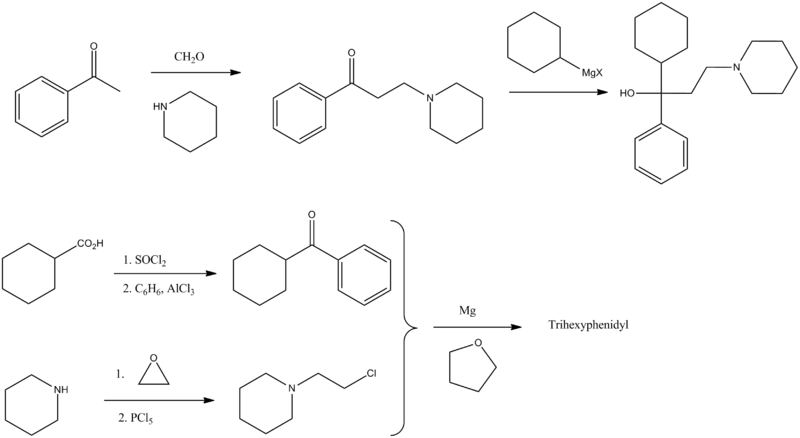Trihexyphenidyl
 | |
 | |
| Clinical data | |
|---|---|
| AHFS/Drugs.com | Monograph |
| MedlinePlus | a682160 |
| Pregnancy category |
|
| Routes of administration | Oral, as tablet or elixir |
| ATC code | N04AA01 (WHO) |
| Legal status | |
| Legal status |
|
| Pharmacokinetic data | |
| Biological half-life | 3.3-4.1 hours |
| Identifiers | |
| |
| CAS Number |
144-11-6 |
| PubChem (CID) | 5572 |
| IUPHAR/BPS | 7315 |
| DrugBank |
DB00376 |
| ChemSpider |
5371 |
| UNII |
6RC5V8B7PO |
| KEGG |
D08638 |
| ChEMBL |
CHEMBL1490 |
| ECHA InfoCard | 100.005.105 |
| Chemical and physical data | |
| Formula | C20H31NO |
| Molar mass | 301.466 g/mol |
| 3D model (Jmol) | Interactive image |
| |
| |
| (verify) | |
Trihexyphenidyl (Artane, Apo-Trihex, Parkin, Pacitane), also known as benzhexol and trihex, is an antiparkinsonian agent of the antimuscarinic class. It has been in clinical usage for decades.
Pharmacology
The exact mechanism of action in parkinsonian syndromes is not precisely understood, but it is known that trihexyphenidyl blocks efferent impulses in parasympathetically innervated structures like smooth muscles (spasmolytic activity), salivary glands, and eyes (mydriasis). In higher doses direct central inhibition of cerebral motor centers may contribute. In very high doses central toxicity as seen in atropine overdose is noted.
It binds to the M1 muscarinic receptor[1] and possibly the dopamine receptor.[2]
Pharmacokinetics
Trihexyphenidyl is rapidly absorbed from the gastrointestinal tract. The onset of action is within 1 hour after oral dosing. The peak activity is noted after 2 to 3 hours. The duration of action of one single dose is 6 to 12 hours in a dose dependent manner. It is excreted in the urine, probably as unchanged drug. More precise data in animals and humans have so far not been determined.
Uses
Trihexyphenidyl is used for the symptomatic treatment of Parkinson's disease in mono- and combination therapy. It is active in postencephalitic, arteriosclerotic, and idiopathic forms. The drug is also commonly used to treat extrapyramidal side effects occurring during antipsychotic treatment. It reduces the frequency and duration of oculogyric crises as well as of dyskinetic movements and spastic contractions. Excessive salivation may also respond. Trihexyphenidyl may improve psychotic depression and mental inertia frequently associated with Parkinson's disease and symptomatic problems caused by antipsychotic treatment.
The drug cannot cure Parkinson's disease, but may provide substantial alleviation of symptoms. An estimated 50 to 75% of patients with Parkinson's disease will react positively and experience a 20 to 30% symptomatic improvement. To increase therapeutic activity trihexyphenidyl is often given concomitantly with levodopa, other antimuscarinic or antihistaminic (e.g. diphenhydramine) agents. Combination treatment with dopaminergic agonists such as cabergoline is also possible. This is often termed a 'multidimensional approach'.
It has also been prescribed for essential tremor and akathisia.
Investigational
Equivocal preliminary results from small studies exist for:
- Other dyskinesias
- Huntington's chorea
- Spasmodic torticollis
- Dystonia[3]
Trihexyphenidyl does not improve cerebral palsy and hemiplegia.
Contraindications and cautions
- Hypersensitivity to trihexyphenidyl
- Narrow angle glaucoma
- Ileus
- Caution : Patients with obstructive diseases of the urogenital tract, patients with a known history of seizures and those with potentially dangerous tachycardia
- Patients under 18 yrs. of age should not be treated due to a lack of clinical experience.
- Patients should allow a period to adjust to the dose when first starting trihexyphenidyl and when the dose has been increased or added to a regimen with other drugs because acute somnolence and accumulated fatigue can make it particularly dangerous to operate an automobile, heavy machinery etc.
Pregnancy and lactation
The safe use of trihexyphenidyl during pregnancy and lactation has not been established.
Side effects
Dose-dependent side effects are frequent. Particularly geriatric patients may react with confusional states or develop delirium.
- Central nervous system: drowsiness, vertigo, headache, and dizziness are frequent. With high doses nervousness, agitation, anxiety, delirium, and confusion are noted. Trihexyphenidyl may be abused due to a short acting mood-elevating and euphoriant effect. The normal sleep architecture may be altered (REM sleep depression). Trihexyphenidyl may lower the seizure-threshold.
- Peripheral side effects: blurred vision, dry mouth, impaired sweating, abdominal discomfort, and constipation are frequent. Tachycardia may be noted. Allergic skin reactions may occur. Parenteral use may cause orthostatic hypotension.
- Eyes: trihexyphenidyl causes mydriasis with or without photophobia. It may precipitate narrow angle glaucoma.
- Tolerance may develop during therapy which requires dose adjustments.
- Striated or (skeletal muscle) Myoflacidicity and weight gain.
Interactions
- Other anticholinergic drugs (e.g. spasmolytics, antihistamines, TCAs) : Side effects of trihexyphenidyl may be increased.
- Quinidine : Increased anticholinergic action (particular on AV conduction).
- Antipsychotics : Long term use of trihexyphenidyl may mask or increase the risk of tardive dyskinesia.
- Pethidine (meperidine) : Central effects and side effects of pethidine may be increased.
- Metoclopramide : Action of metoclopramide is decreased.
- Alcohol : Risk of serious intoxication.
Overdose
Trihexyphenidyl mimics an atropine intoxication with mydriasis, dryness of mucous membranes, red face, atonic states of bowels and bladder, and hyperthermia in high doses. Central consequences are agitation, confusion, and hallucinations. An untreated overdose may be fatal, particularly in children. Premortal signs are respiratory depression and cardiac arrest. A specific antagonist is physostigmine which combines a peripheral and a central action. Carbachol can be used to treat atonic bowel and bladder. The vital functions should be monitored and stabilized. It may be necessary to treat hyperthermia with cooling blankets.
Recreational use
In a 2008 news report, trihexyphenidyl has been used recreationally among Iraqi soldiers and police, among other prescription drugs. The report states that the drugs were taken to relieve combat stress.[4]
The neurologist Oliver Sacks reports using the drug recreationally in the 1960s.[5]
The street names for trihexyphenidyl include its trade name Artane and courage, octane, Sexy Trihexy, T Rex, Tri-Sexual.
Synthesis
Trihexyphenidyl can be synthesized in two ways, one linear and one convergent synthesis.
In the first way, the initial 2-(1-piperidino)propiophenone is synthesized in turn by the aminomethylation of acetophenone using paraformaldehyde and piperidine in a Mannich reaction. In the second step the 2-(1-piperidino)propiophenone is reacted with cyclohexylmagnesium bromide in a Grignard reaction.[6][7][8][9]

See also
- Biperiden (bicyclic ring)
- Cycrimine (cyclopentanyl instead of cyclohexanyl)
- Gamfexine
- Procyclidine
References
- ↑ Giachetti, A.; Giraldo, E.; Ladinsky, H.; Montagna, E. (1986). "Binding and functional profiles of the selective M1 muscarinic receptor antagonists trihexyphenidyl and dicyclomine". British Journal of Pharmacology. 89 (1): 83–90. doi:10.1111/j.1476-5381.1986.tb11123.x. PMC 1917044
 . PMID 2432979.
. PMID 2432979. - ↑ Berke, J. D.; Hyman, S. E. (2000). "Addiction, dopamine, and the molecular mechanisms of memory". Neuron. 25 (3): 515–532. doi:10.1016/S0896-6273(00)81056-9. PMID 10774721.
- ↑ Sanger, T. D.; Bastian, A.; Brunstrom, J.; Damiano, D.; Delgado, M.; Dure, L.; Gaebler-Spira, D.; Hoon, A.; Mink, J. W.; Sherman-Levine, S.; Welty, L. J.; Child Motor Study, G. (2007). "Prospective Open-Label Clinical Trial of Trihexyphenidyl in Children with Secondary Dystonia due to Cerebral Palsy". Journal of Child Neurology. 22 (5): 530–537. doi:10.1177/0883073807302601. PMID 17690057.
- ↑ Mudhafer Al-Husaini; Erica Goode (2008-12-20), Abuse of Prescription Drugs Rises Among Stressed Iraqi Soldiers, New York Times
- ↑ Oliver Sacks shares his hallucinations, Guardian, 2012-10-30
- ↑ US patent 2680115, Wayne, R. A., "Substituted tertiary-aminoalkyl carbinols", issued 1954-06-01
- ↑ US patent 2716121, Denton, J. J., "Basic tertiary piperidino alcohols", issued 1955-08-23
- ↑ US patent 2682543, Wilkinson, S. & Adamson, D. W., "Catalytic reduction of diphenyl-alkanolamines", issued 1954-06-29
- ↑ GB patent 750156, Adamson, D. W. & Duffin, W., "Improvements in cyclohexyl-phenyl-amino-propanols", issued 1956-06-13
External links
- Trihexyphenidyl, mentalhealth.com